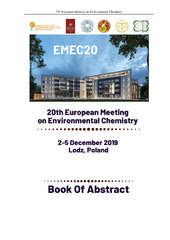Приказ основних података о документу
Distribution of saturated hydrocarbons in unweathered and erosional landforms
| dc.creator | Kašanin-Grubin, Milica | |
| dc.creator | Stefanović, Milica | |
| dc.creator | Jovančićević, Branimir | |
| dc.creator | Šajnović, Aleksandra | |
| dc.date.accessioned | 2023-03-20T08:12:19Z | |
| dc.date.available | 2023-03-20T08:12:19Z | |
| dc.date.issued | 2019 | |
| dc.identifier.uri | http://TechnoRep.tmf.bg.ac.rs/handle/123456789/6162 | |
| dc.description.abstract | Badlands are worldwide erosional landforms. The formation of different badland morphologies is due to the type of sedimentary bedrock, especially texture and cementation degree, as well as climate. In this study badlandes mudstones which have high silt and clay contents from different locations in Italy, Spain and Canada (Figure 1) were investigated from organic-geochemical point of view. It is known that vegetation is commonly identified as a significant controlling mechanism of land degradation in sensitive, semi-arid environments [1]. Total of 18 samples were analysed from 9 different locations. From each location unweathered mudstone and crust were taken. Qualitative and semiquantitative composition of the mineral part of samples was determined using X-ray diffractometer. Additionally, chemical properties such as pH, EC, Eh, SAR are determined. The content of organic carbon (Corg), was determined by elemental analysis after removal of carbonates with diluted hydrochloric acid (1:3, v/v). Soluble organic matter, bitumen, was extracted from sediments using the Soxhlet extraction with an azeotrope mixture of dichloromethan and methanol (88:12, volume %). Isolation of the saturated and aromatic fraction was done using column chromatography. Organic compound were analyzed by gas chromatography-mass spectrometry (GC-MS) technique in the fractions of saturated hydrocarbons. Many study has shown that clay mineralogy is extremely important for the behaviour of different materials undergone weathering/erosional processes as well as smectite-containing sediments have been shown to be more erodable [2]. Additonally, the presence of enough amount of organic matter, iron and aluminum oxides causes to make marls durable while, sodium ions cause more erosion associated with dispersed clay particles [3]. In this study, it was observed that major changes in the distribution of saturated hydrocarbons occurred in samples containing smectite compared to those samples where mentioned mineral was not identified. This confirms that the presence of smectite is crucial factor for changes inorganic and organic matter during erosional processes. Mentioned changes in distribution of saturated hydrocarbons are most pronounced for n-alkanes, whereby higher odd-numbered n-alkanes are most sensitive during erosive processes. For that reason parameters which reflect the ratio of higher and lower n-alkanes (for example, TAR, TAR/MAR, CPI) decrease in eroded samples compared to unweathered mudstones. Significant changes in distribution of polycyclic alkanes of sterane and terpane types were not observed. | sr |
| dc.language.iso | en | sr |
| dc.publisher | Lodz University of Technology | sr |
| dc.relation | info:eu-repo/grantAgreement/MESTD/Basic Research (BR or ON)/176006/RS// | sr |
| dc.rights | openAccess | sr |
| dc.rights.uri | https://creativecommons.org/licenses/by/4.0/ | |
| dc.source | 20th European Meeting on Environmental Chemistry 2019 | sr |
| dc.title | Distribution of saturated hydrocarbons in unweathered and erosional landforms | sr |
| dc.type | conferenceObject | sr |
| dc.rights.license | BY | sr |
| dc.citation.spage | 116 | |
| dc.identifier.fulltext | http://TechnoRep.tmf.bg.ac.rs/bitstream/id/16573/bitstream_16573.pdf | |
| dc.identifier.rcub | https://hdl.handle.net/21.15107/rcub_technorep_6162 | |
| dc.type.version | publishedVersion | sr |

